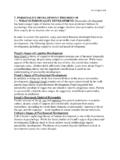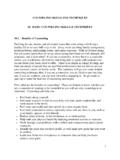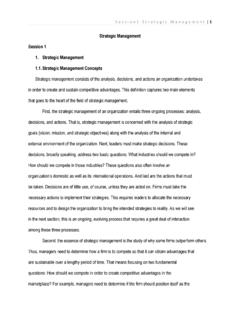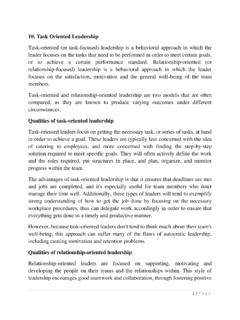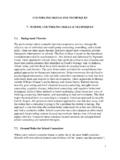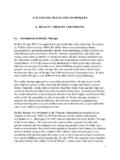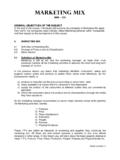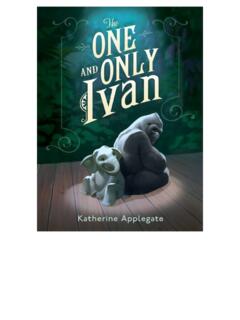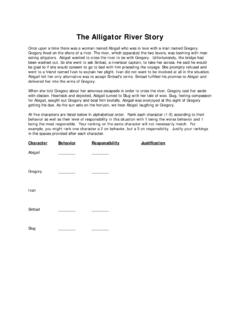Transcription of 9. BEHAVIORAL APPROACHES 9.1 PAVLOV
1 SEC 4 Page 1 of 11 9. BEHAVIORAL APPROACHES PAVLOV : Ivan Petrovich PAVLOV was a Russian physiologist known primarily for his work in classical conditioning. From his childhood days PAVLOV demonstrated intellectual brilliance along with an unusual energy which he named "the instinct for research". Inspired by the progressive ideas which D. I. Pisarev, the most eminent of the Russian literary critics of the 1860s and I. M. Sechenov, the father of Russian physiology, were spreading, PAVLOV abandoned his religious career and decided to devote his life to science. In 1870 he enrolled in the physics and mathematics faculty at the University of Saint Petersburg to take the course in natural science.
2 Ivan PAVLOV devoted his life to the study of physiology and sciences, making several remarkable discoveries and ideas that were passed on from generation to generation. He won the Nobel Prize for Physiology or Medicine in 1904. After completing his doctorate, PAVLOV went to Germany where he studied in Leipzig with Carl Ludwig in the Heidenhain laboratories in Breslau. He remained there from 1884 to 1886. Heidenhain was studying digestion in dogs, using an exteriorized section of the stomach. However, PAVLOV perfected the technique by overcoming the problem of maintaining the external nerve supply. The exteriorized section became known as the Heidenhain or PAVLOV pouch. PAVLOV was invited to the Institute of Experimental Medicine in 1891 to organize and direct the Department of Physiology.
3 Over a 45 year period, under his direction it became one of the most important centers of physiological research. While PAVLOV directed the Department of Physiology at the Institute, he also transferred to the chair of physiology at the Medical Military Academy. This change in positions at the Academy occurred in 1895. He headed the physiology department at the Academy continuously for three decades. Also, starting in 1901, PAVLOV was nominated for the Nobel Prize in Physiology or Medicine for four successive years. However, he did not win because his nominations were not specific to any discovery and were based on a variety of laboratory findings. In 1904, PAVLOV was awarded the Nobel laureate"in recognition of his work on the physiology of digestion, through which knowledge on vital aspects of the subject has been transformed and enlarged" Pavlovian Conditioning PAVLOV (1902) started from the idea that there are some things that a dog does not need to learn.
4 For example, dogs don t learn to salivate whenever they see food. This reflex is hard wired into the dog. In behaviorist terms, it is an unconditioned SEC 4 Page 2 of 11 response ( a stimulus-response connection that required no learning). In behaviorist terms, we write: Unconditioned Stimulus (Food) > Unconditioned Response (Salivate) PAVLOV showed the existence of the unconditioned response by presenting a dog with a bowl of food and the measuring its salivary secretions (see image below). However, when PAVLOV discovered that any object or event which the dogs learnt toassociate with food (such as the lab assistant) would trigger the same response, he realized that he had made an important scientific discovery, and he devoted the rest of his career to studying this type of learning.
5 PAVLOV knew that somehow, the dogs in his lab had learned to associate food with his lab assistant. This must have been learned, because at one point the dogs did not do it, and there came a point where they started, so their behavior had changed. A change in behavior of this type must be the result of learning. In behaviorist terms, the lab assistant was originally a neutral stimulus. It is called neutral because it produces no response. What had happened was that the neutral stimulus (the lab assistant) had become associated with an unconditioned stimulus (food). In his experiment, PAVLOV used a bell as his neutral stimulus. Whenever he gave food to his dogs, he also rang a bell. After a number of repeats of this procedure, he tried the bell on its own.
6 As you might expect, the bell on its own now caused an increase in salivation. So the dog had learned an association between the bell and the food and a new behavior had been learnt. Because this response was learned (or conditioned), it is called a conditioned response. The neutral stimulus has become a conditioned stimulus. PAVLOV found that for associations to be made, the two stimuli had to be presented close together in time. He called this the law of temporal contiguity. If the time between the conditioned stimulus (bell) and unconditioned stimulus (food) is too great, then learning will not occur. SEC 4 Page 3 of 11 PAVLOV and his studies of classical conditioning have become famous since his early work between 1890-1930.
7 Classical conditioning is "classical" in that it is the first systematic study of basic laws of learning / conditioning. Summary To summarize, classical conditioning (later developed by John Watson) involves learning to associate an unconditioned stimulus that already brings about a particular response ( a reflex) with a new (conditioned) stimulus, so that the new stimulus brings about the same response. PAVLOV developed some rather unfriendly technical terms to describe this process. The unconditioned stimulus (or UCS) is the object or event that originally produces the reflexive / natural response. The response to this is called the unconditioned response (or UCR). The neutral stimulus (NS) is a new stimulus that does not produce a response.
8 Once the neutral stimulus has become associated with the unconditioned stimulus, it becomes a conditioned stimulus (CS). The conditioned response (CR) is the response to the conditioned stimulus. BANDURA: In social learning theory Albert Bandura (1977) states behavior is learned from the environment through the process of observational learning. Unlike Skinner, Bandura (1977) believes that humans are active information processors and think about the relationship between their behavior and its consequences. Observational learning could not occur unless cognitive processes were at work. Children observe the people around them behaving in various ways. This is illustrated during the famous bobo doll experiment (Bandura, 1961).
9 Individuals that are observed are called models. In society children are surrounded by many influential models, such as parents within the family, characters on children s TV, friends within their peer group and teachers at school. These models provide examples of behavior to observe and imitate, masculine and feminine, pro and anti-social etc. Children pay attention to some of these people (models) and encode their behavior. At a later time they may imitate ( copy) the behavior they have observed. They may do this regardless of whether the behavior is gender SEC 4 Page 4 of 11 appropriate or not but there are a number of processes that make it more likely that a child will reproduce the behavior that its society deems appropriate for its sex.
10 First, the child is more likely to attend to and imitate those people it perceives as similar to itself. Consequently, it is more likely to imitate behavior modeled by people of the same sex. Second, the people around the child will respond to the behavior it imitates with either reinforcement or punishment. If a child imitates a model s behavior and the consequences are rewarding, the child is likely to continue performing the behavior. If parent sees a little girl consoling her teddy bear and says what a kind girl you are , this is rewarding for the child and makes it more likely that she will repeat the behavior. Her behavior has been reinforced ( strengthened). Reinforcement can be external or internal and can be positive or negative.
